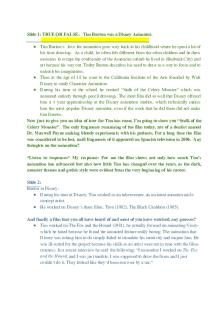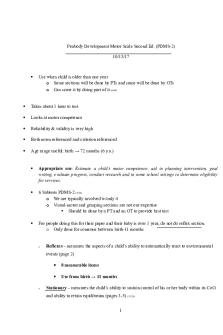A1-Constraints - KNES370: DR. TIM KIEMEL MOTOR DEVELOPMENT PDF

| Title | A1-Constraints - KNES370: DR. TIM KIEMEL MOTOR DEVELOPMENT |
|---|---|
| Course | Motor Development |
| Institution | University of Maryland |
| Pages | 4 |
| File Size | 80.9 KB |
| File Type | |
| Total Downloads | 51 |
| Total Views | 138 |
Summary
KNES370: DR. TIM KIEMEL MOTOR DEVELOPMENT...
Description
Sardonna Siu KNES370 Section 0104 A1-Constraints: Part I: The chosen motor skill I am going to use for this assignment is spiking a volleyball. Volleyball may be played in an indoor court or outside on the beach. In this motor skill, you start by standing in the front of the court, close to the net, then watch the setter for the when they hit the ball high in the air, then when it is at the correct position in the air, jump and hit the volleyball down across the net with your palm forcefully. A successful spike will leave the volleyball on your opponent’s side of the net, but it is preferred that the ball does not get returned to your side of the net. If the ball hits the floor on your opponent’s side of the net after you spike the ball, your team gets a point and the play for the next point starts.
Part II: FMP Period: •
Individual Constraint: Personal Height is a constraint during the FMP period because you are only just learning how to jump. It may be difficult to simultaneously learn to jump and jump as high as possible. At this age, you are also still a child, so your height is very short and will not be able to jump at high heights.
•
Environmental Constraint: Gravity is an environmental constraint during the FMP period because when you jump, gravity eventually pulls you back to the ground. It will stop the child from getting more height in their jump.
Context-Specific Period:
•
Sardonna Siu KNES370 Section 0104 Individual Constraint: Arm length is a constraint in the context-specific period because though you may not have a lot of height in your jump, your arm length could make up for it. If your arms are not long enough to reach other the net, you may not be able to slam the ball across or at least with not enough force.
•
Task Constraint: The height of the volleyball net its a task constraint during the contextspecific period because you don’t realize how much height you must get within your jump in order for the ball to go over the net.
Skillful Period: •
Individual Constraint: Fear is a good example of a constraint in the skillful period because you enjoy the sport of volleyball but you are scared that you will not be good when playing in a competitive setting or will let your teammates down.
•
Environmental Constraint: For the volleyball game being played outdoors, the light level from the sun may be a constraint because if the sun is too bright or there is little light, it will be difficult to keep your eye on the ball as the game is being played. One of the most important skills as a spiker is to keep your eye on the ball.
Compensation Period: (Leg Injury Leading to Amputation) •
Individual Constraint: After a leg amputation, motivation is a constraint because you are not going to perform at the level you were before, which can be hard to want to keep going.
•
Environmental Constraint: The sociocultural environment is a constraint because the “norm” is to see volleyball players with all functioning natural limbs and very fit bodies, not those amputated and just trying to get back on their feet and relearning basic skills, such as walking.
Sardonna Siu KNES370 Section 0104
Part III: The period I will focus deeper on is the Fundamental Motor Patterns Period (FMP), when fundamental motor skills are developing. The skills built within this period are typically phylogenetic and are the “building-blocks” necessary for more specific skills in later periods. In the specific motor skill of spiking a volleyball, the two important fundamental skills are jumping and intercepting a ball with a hit with your hands. The individual constraints for jumping are mostly related to body size. One may find it difficult to jump “high” due to their height in comparison to others and their weight may drag them down further. Their mental fear may play as a constraint in jumping because children are afraid to fall. In intercepting the ball, individual constraints are mainly functional; kids may be scared about a ball coming towards them or they may have a short attentional focus, diverting their eyes off from ball and away from the goal of intercepting it. The environmental constraints can also determine how the child performs these fundamental skills. For jumping, environmental constraints may include gravity and temperature, if jumping outdoors. Gravity will ultimately bring the individual back down to the ground and may inhibit the height go their jump. If they are just learning to jump, they may be discouraged because they can’t get higher. Temperature could also be a constraint because if it is too hot, an individual, especially with that small if a body, can overheat quickly and lose energy, therefore inhibiting their ability to jump for longer. Intercepting a ball also has environmental constraints, such as wind, and family support networks. In addition to cold temperatures, the wind could push
Sardonna Siu KNES370 Section 0104 the ball in any direction and makes it more difficult for the child to hit, where their hands may already be frozen by the cold. Family support can also be a constraint because the child may have a family history of volleyball players, where they unknowingly place pressure on the child to also participate. This makes the child stressed to hit every ball that comes their way. The task constraint of the ball size and weight is important to mention because in the FMP period, these individuals are only children; the balls being thrown may be too big or too heavy for them to intercept....
Similar Free PDFs

Gross-Motor Development Essay
- 7 Pages

Chapter 5 Motor Development
- 22 Pages

Atu: Motor development
- 8 Pages

Tim Burton
- 7 Pages

Tim Horton’s Risk Management
- 4 Pages

Makalah Manajemen metode tim
- 33 Pages
Popular Institutions
- Tinajero National High School - Annex
- Politeknik Caltex Riau
- Yokohama City University
- SGT University
- University of Al-Qadisiyah
- Divine Word College of Vigan
- Techniek College Rotterdam
- Universidade de Santiago
- Universiti Teknologi MARA Cawangan Johor Kampus Pasir Gudang
- Poltekkes Kemenkes Yogyakarta
- Baguio City National High School
- Colegio san marcos
- preparatoria uno
- Centro de Bachillerato Tecnológico Industrial y de Servicios No. 107
- Dalian Maritime University
- Quang Trung Secondary School
- Colegio Tecnológico en Informática
- Corporación Regional de Educación Superior
- Grupo CEDVA
- Dar Al Uloom University
- Centro de Estudios Preuniversitarios de la Universidad Nacional de Ingeniería
- 上智大学
- Aakash International School, Nuna Majara
- San Felipe Neri Catholic School
- Kang Chiao International School - New Taipei City
- Misamis Occidental National High School
- Institución Educativa Escuela Normal Juan Ladrilleros
- Kolehiyo ng Pantukan
- Batanes State College
- Instituto Continental
- Sekolah Menengah Kejuruan Kesehatan Kaltara (Tarakan)
- Colegio de La Inmaculada Concepcion - Cebu









